| diagram |  |
||||||||||||||||||||||||||||||||||||||||||||||||||||||||||||||
| namespace | urn:ebu:metadata-schema:ebuCore_2014 | ||||||||||||||||||||||||||||||||||||||||||||||||||||||||||||||
| children | ebucore:name ebucore:givenName ebucore:familyName ebucore:otherGivenName ebucore:suffix ebucore:salutation ebucore:birthDate ebucore:deathDate ebucore:username ebucore:nickname ebucore:occupation ebucore:details ebucore:stageName ebucore:guest ebucore:gender ebucore:relatedInformationLink ebucore:relatedContacts ebucore:skill | ||||||||||||||||||||||||||||||||||||||||||||||||||||||||||||||
| used by |
|
||||||||||||||||||||||||||||||||||||||||||||||||||||||||||||||
| attributes |
|
||||||||||||||||||||||||||||||||||||||||||||||||||||||||||||||
| annotation |
|
||||||||||||||||||||||||||||||||||||||||||||||||||||||||||||||
| source | <xs:complexType name="contactDetailsType"> <xs:annotation> <xs:documentation> To provide all the information necessary to contact and locate a person. </xs:documentation> </xs:annotation> <xs:sequence> <xs:choice> <xs:element name="name" type="ebucore:compoundNameType" minOccurs="0" maxOccurs="unbounded"> <xs:annotation> <xs:documentation>The contact name is optional as a contact maybe identified by its contactId. The name is a combination of different elements of information for a specific purpose such as a name for display.</xs:documentation> </xs:annotation> </xs:element> <xs:sequence> <xs:element name="givenName" type="ebucore:elementType" minOccurs="0"> <xs:annotation> <xs:documentation>Also know as the first name among others.</xs:documentation> </xs:annotation> </xs:element> <xs:element name="familyName" type="ebucore:elementType" minOccurs="0"> <xs:annotation> <xs:documentation> also know as the last name among others.</xs:documentation> </xs:annotation> </xs:element> <xs:element name="otherGivenName" type="ebucore:elementType" minOccurs="0" maxOccurs="unbounded"> <xs:annotation> <xs:documentation>e.g. a middle name.</xs:documentation> </xs:annotation> </xs:element> <xs:element name="suffix" type="ebucore:elementType" minOccurs="0"> <xs:annotation> <xs:documentation> E.g. 'Jr' for junior or 'Sr' for senior. </xs:documentation> </xs:annotation> </xs:element> <xs:element name="salutation" type="ebucore:elementType" minOccurs="0"> <xs:annotation> <xs:documentation>E.g. M., Ms., Mrs, Pr., Dr.</xs:documentation> </xs:annotation> </xs:element> <xs:element name="birthDate" type="date"> <xs:annotation> <xs:documentation> The date of birth. </xs:documentation> </xs:annotation> </xs:element> <xs:element name="deathDate" type="date"> <xs:annotation> <xs:documentation> The date of death. </xs:documentation> </xs:annotation> </xs:element> </xs:sequence> </xs:choice> <xs:element name="username" type="ebucore:elementType" minOccurs="0" maxOccurs="unbounded"> <xs:annotation> <xs:documentation>The name used by the contact in a particular context.</xs:documentation> </xs:annotation> </xs:element> <xs:element name="nickname" type="ebucore:elementType" minOccurs="0" maxOccurs="unbounded"> <xs:annotation> <xs:documentation>A name given to the contact.</xs:documentation> </xs:annotation> </xs:element> <xs:element name="occupation" type="ebucore:elementType" minOccurs="0"> <xs:annotation> <xs:documentation>The job function of the contact</xs:documentation> </xs:annotation> </xs:element> <xs:element name="details" type="ebucore:detailsType" minOccurs="0" maxOccurs="unbounded"> <xs:annotation> <xs:documentation> The detailed contact information of a person/contact. </xs:documentation> </xs:annotation> </xs:element> <xs:element name="stageName" type="ebucore:elementType" minOccurs="0" maxOccurs="unbounded"> <xs:annotation> <xs:documentation>For example, in the case a contact is a performing actor/actress, the stage name will be the fictitious character's name</xs:documentation> </xs:annotation> </xs:element> <xs:element name="guest" type="boolean" minOccurs="0"> <xs:annotation> <xs:documentation>A flag to indicate if the contact contribution/appearance was as a guest</xs:documentation> </xs:annotation> </xs:element> <xs:element name="gender" type="ebucore:elementType" minOccurs="0"> <xs:annotation> <xs:documentation> An element to facilitate filtering / search on gender, e.g. male or female. </xs:documentation> </xs:annotation> </xs:element> <xs:element name="relatedInformationLink" minOccurs="0" maxOccurs="unbounded"> <xs:annotation> <xs:documentation>To provide links with related information such as Wikipedia or other web pages (e.g. press releases).</xs:documentation> </xs:annotation> <xs:complexType> <xs:simpleContent> <xs:extension base="anyURI"> <xs:attributeGroup ref="ebucore:typeGroup"> <xs:annotation> <xs:documentation> A group of attributes to define the type of link provided. </xs:documentation> </xs:annotation> </xs:attributeGroup> </xs:extension> </xs:simpleContent> </xs:complexType> </xs:element> <xs:element name="relatedContacts" type="ebucore:entityType" minOccurs="0" maxOccurs="unbounded"> <xs:annotation> <xs:documentation>This is used to identify contacts (e.g. an assistant, an agent) related to the contact/person being described. </xs:documentation> </xs:annotation> </xs:element> <xs:element name="skill" type="string" minOccurs="0" maxOccurs="unbounded"> <xs:annotation> <xs:documentation>To provide additional information on a contact/person's particular abilities. </xs:documentation> </xs:annotation> </xs:element> </xs:sequence> <xs:attribute name="contactId" type="anyURI"> <xs:annotation> <xs:documentation> To provide a unique identifier for a contact. </xs:documentation> </xs:annotation> </xs:attribute> <xs:attributeGroup ref="ebucore:typeGroup"> <xs:annotation> <xs:documentation> To define a type fo contact. </xs:documentation> </xs:annotation> </xs:attributeGroup> <xs:attribute name="lastUpdate" type="date"> <xs:annotation> <xs:documentation> To provide a date when this information was last known to be valid. </xs:documentation> </xs:annotation> </xs:attribute> </xs:complexType> |
attribute contactDetailsType/@contactId
| type | xs:anyURI | ||
| annotation |
|
||
| source | <xs:attribute name="contactId" type="anyURI"> <xs:annotation> <xs:documentation> To provide a unique identifier for a contact. </xs:documentation> </xs:annotation> </xs:attribute> |
attribute contactDetailsType/@lastUpdate
| type | xs:date | ||
| annotation |
|
||
| source | <xs:attribute name="lastUpdate" type="date"> <xs:annotation> <xs:documentation> To provide a date when this information was last known to be valid. </xs:documentation> </xs:annotation> </xs:attribute> |
element contactDetailsType/name
| diagram |  |
||||||||||||||||||||||||||||||||||||||||||||||||||||||||||||||||||||||||||||||||||||||||||||||||||||||||||||||||||||
| namespace | urn:ebu:metadata-schema:ebuCore_2014 | ||||||||||||||||||||||||||||||||||||||||||||||||||||||||||||||||||||||||||||||||||||||||||||||||||||||||||||||||||||
| type | ebucore:compoundNameType | ||||||||||||||||||||||||||||||||||||||||||||||||||||||||||||||||||||||||||||||||||||||||||||||||||||||||||||||||||||
| properties |
|
||||||||||||||||||||||||||||||||||||||||||||||||||||||||||||||||||||||||||||||||||||||||||||||||||||||||||||||||||||
| attributes |
|
||||||||||||||||||||||||||||||||||||||||||||||||||||||||||||||||||||||||||||||||||||||||||||||||||||||||||||||||||||
| annotation |
|
||||||||||||||||||||||||||||||||||||||||||||||||||||||||||||||||||||||||||||||||||||||||||||||||||||||||||||||||||||
| source | <xs:element name="name" type="ebucore:compoundNameType" minOccurs="0" maxOccurs="unbounded"> <xs:annotation> <xs:documentation>The contact name is optional as a contact maybe identified by its contactId. The name is a combination of different elements of information for a specific purpose such as a name for display.</xs:documentation> </xs:annotation> </xs:element> |
element contactDetailsType/givenName
| diagram | 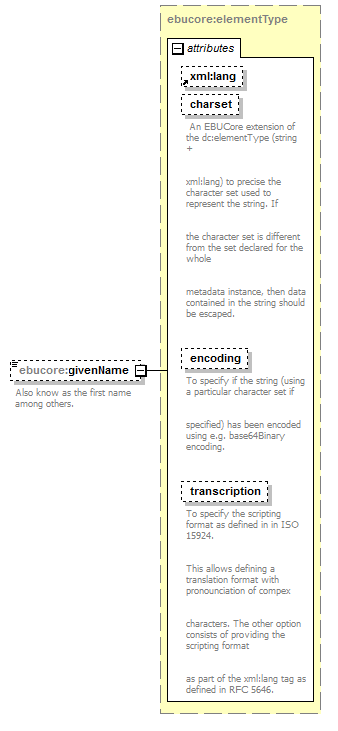 |
||||||||||||||||||||||||||||||||||||
| namespace | urn:ebu:metadata-schema:ebuCore_2014 | ||||||||||||||||||||||||||||||||||||
| type | ebucore:elementType | ||||||||||||||||||||||||||||||||||||
| properties |
|
||||||||||||||||||||||||||||||||||||
| attributes |
|
||||||||||||||||||||||||||||||||||||
| annotation |
|
||||||||||||||||||||||||||||||||||||
| source | <xs:element name="givenName" type="ebucore:elementType" minOccurs="0"> <xs:annotation> <xs:documentation>Also know as the first name among others.</xs:documentation> </xs:annotation> </xs:element> |
element contactDetailsType/familyName
| diagram |  |
||||||||||||||||||||||||||||||||||||
| namespace | urn:ebu:metadata-schema:ebuCore_2014 | ||||||||||||||||||||||||||||||||||||
| type | ebucore:elementType | ||||||||||||||||||||||||||||||||||||
| properties |
|
||||||||||||||||||||||||||||||||||||
| attributes |
|
||||||||||||||||||||||||||||||||||||
| annotation |
|
||||||||||||||||||||||||||||||||||||
| source | <xs:element name="familyName" type="ebucore:elementType" minOccurs="0"> <xs:annotation> <xs:documentation> also know as the last name among others.</xs:documentation> </xs:annotation> </xs:element> |
element contactDetailsType/otherGivenName
| diagram | 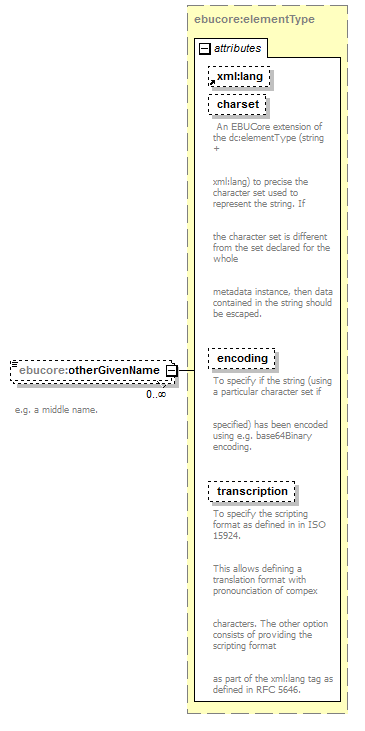 |
||||||||||||||||||||||||||||||||||||
| namespace | urn:ebu:metadata-schema:ebuCore_2014 | ||||||||||||||||||||||||||||||||||||
| type | ebucore:elementType | ||||||||||||||||||||||||||||||||||||
| properties |
|
||||||||||||||||||||||||||||||||||||
| attributes |
|
||||||||||||||||||||||||||||||||||||
| annotation |
|
||||||||||||||||||||||||||||||||||||
| source | <xs:element name="otherGivenName" type="ebucore:elementType" minOccurs="0" maxOccurs="unbounded"> <xs:annotation> <xs:documentation>e.g. a middle name.</xs:documentation> </xs:annotation> </xs:element> |
element contactDetailsType/suffix
| diagram |  |
||||||||||||||||||||||||||||||||||||
| namespace | urn:ebu:metadata-schema:ebuCore_2014 | ||||||||||||||||||||||||||||||||||||
| type | ebucore:elementType | ||||||||||||||||||||||||||||||||||||
| properties |
|
||||||||||||||||||||||||||||||||||||
| attributes |
|
||||||||||||||||||||||||||||||||||||
| annotation |
|
||||||||||||||||||||||||||||||||||||
| source | <xs:element name="suffix" type="ebucore:elementType" minOccurs="0"> <xs:annotation> <xs:documentation> E.g. 'Jr' for junior or 'Sr' for senior. </xs:documentation> </xs:annotation> </xs:element> |
element contactDetailsType/salutation
| diagram | 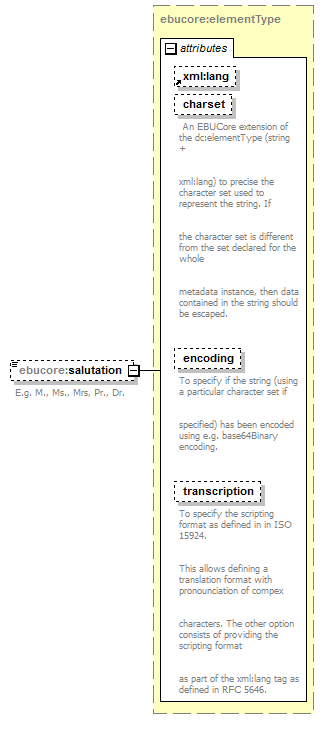 |
||||||||||||||||||||||||||||||||||||
| namespace | urn:ebu:metadata-schema:ebuCore_2014 | ||||||||||||||||||||||||||||||||||||
| type | ebucore:elementType | ||||||||||||||||||||||||||||||||||||
| properties |
|
||||||||||||||||||||||||||||||||||||
| attributes |
|
||||||||||||||||||||||||||||||||||||
| annotation |
|
||||||||||||||||||||||||||||||||||||
| source | <xs:element name="salutation" type="ebucore:elementType" minOccurs="0"> <xs:annotation> <xs:documentation>E.g. M., Ms., Mrs, Pr., Dr.</xs:documentation> </xs:annotation> </xs:element> |
element contactDetailsType/birthDate
| diagram |  |
||
| namespace | urn:ebu:metadata-schema:ebuCore_2014 | ||
| type | xs:date | ||
| properties |
|
||
| annotation |
|
||
| source | <xs:element name="birthDate" type="date"> <xs:annotation> <xs:documentation> The date of birth. </xs:documentation> </xs:annotation> </xs:element> |
element contactDetailsType/deathDate
| diagram |  |
||
| namespace | urn:ebu:metadata-schema:ebuCore_2014 | ||
| type | xs:date | ||
| properties |
|
||
| annotation |
|
||
| source | <xs:element name="deathDate" type="date"> <xs:annotation> <xs:documentation> The date of death. </xs:documentation> </xs:annotation> </xs:element> |
element contactDetailsType/username
| diagram | 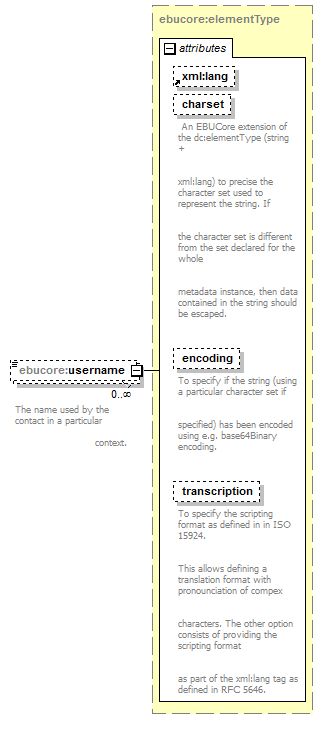 |
||||||||||||||||||||||||||||||||||||
| namespace | urn:ebu:metadata-schema:ebuCore_2014 | ||||||||||||||||||||||||||||||||||||
| type | ebucore:elementType | ||||||||||||||||||||||||||||||||||||
| properties |
|
||||||||||||||||||||||||||||||||||||
| attributes |
|
||||||||||||||||||||||||||||||||||||
| annotation |
|
||||||||||||||||||||||||||||||||||||
| source | <xs:element name="username" type="ebucore:elementType" minOccurs="0" maxOccurs="unbounded"> <xs:annotation> <xs:documentation>The name used by the contact in a particular context.</xs:documentation> </xs:annotation> </xs:element> |
element contactDetailsType/nickname
| diagram | 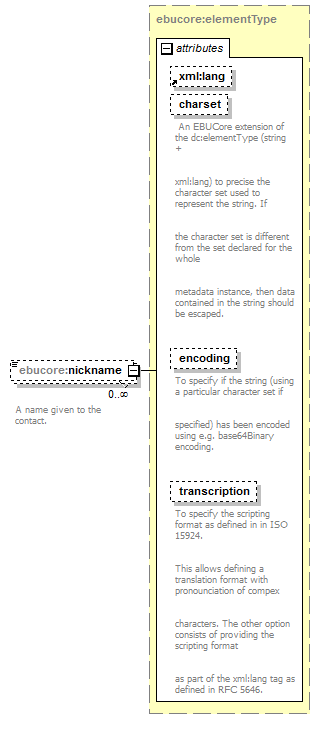 |
||||||||||||||||||||||||||||||||||||
| namespace | urn:ebu:metadata-schema:ebuCore_2014 | ||||||||||||||||||||||||||||||||||||
| type | ebucore:elementType | ||||||||||||||||||||||||||||||||||||
| properties |
|
||||||||||||||||||||||||||||||||||||
| attributes |
|
||||||||||||||||||||||||||||||||||||
| annotation |
|
||||||||||||||||||||||||||||||||||||
| source | <xs:element name="nickname" type="ebucore:elementType" minOccurs="0" maxOccurs="unbounded"> <xs:annotation> <xs:documentation>A name given to the contact.</xs:documentation> </xs:annotation> </xs:element> |
element contactDetailsType/occupation
| diagram | 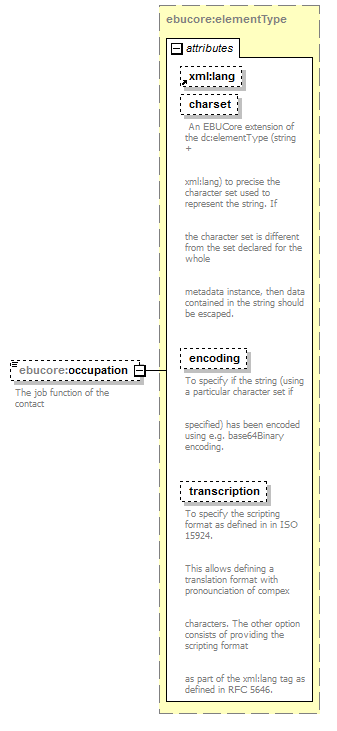 |
||||||||||||||||||||||||||||||||||||
| namespace | urn:ebu:metadata-schema:ebuCore_2014 | ||||||||||||||||||||||||||||||||||||
| type | ebucore:elementType | ||||||||||||||||||||||||||||||||||||
| properties |
|
||||||||||||||||||||||||||||||||||||
| attributes |
|
||||||||||||||||||||||||||||||||||||
| annotation |
|
||||||||||||||||||||||||||||||||||||
| source | <xs:element name="occupation" type="ebucore:elementType" minOccurs="0"> <xs:annotation> <xs:documentation>The job function of the contact</xs:documentation> </xs:annotation> </xs:element> |
element contactDetailsType/details
| diagram | 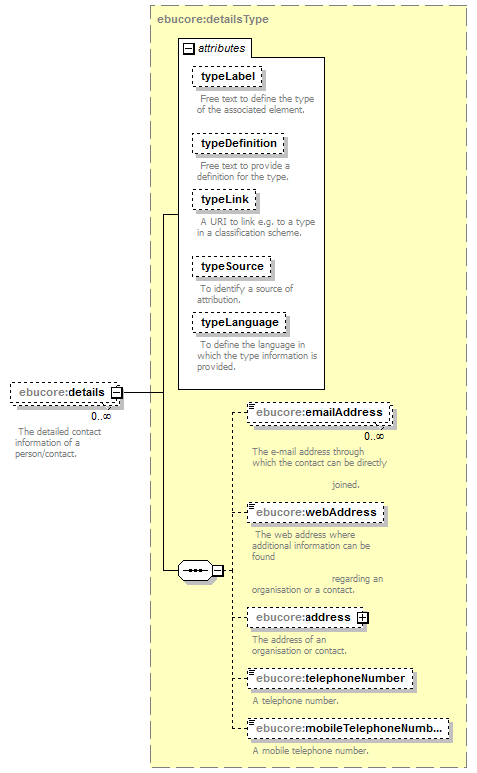 |
||||||||||||||||||||||||||||||||||||||||||||||
| namespace | urn:ebu:metadata-schema:ebuCore_2014 | ||||||||||||||||||||||||||||||||||||||||||||||
| type | ebucore:detailsType | ||||||||||||||||||||||||||||||||||||||||||||||
| properties |
|
||||||||||||||||||||||||||||||||||||||||||||||
| children | ebucore:emailAddress ebucore:webAddress ebucore:address ebucore:telephoneNumber ebucore:mobileTelephoneNumber | ||||||||||||||||||||||||||||||||||||||||||||||
| attributes |
|
||||||||||||||||||||||||||||||||||||||||||||||
| annotation |
|
||||||||||||||||||||||||||||||||||||||||||||||
| source | <xs:element name="details" type="ebucore:detailsType" minOccurs="0" maxOccurs="unbounded"> <xs:annotation> <xs:documentation> The detailed contact information of a person/contact. </xs:documentation> </xs:annotation> </xs:element> |
element contactDetailsType/stageName
| diagram |  |
||||||||||||||||||||||||||||||||||||
| namespace | urn:ebu:metadata-schema:ebuCore_2014 | ||||||||||||||||||||||||||||||||||||
| type | ebucore:elementType | ||||||||||||||||||||||||||||||||||||
| properties |
|
||||||||||||||||||||||||||||||||||||
| attributes |
|
||||||||||||||||||||||||||||||||||||
| annotation |
|
||||||||||||||||||||||||||||||||||||
| source | <xs:element name="stageName" type="ebucore:elementType" minOccurs="0" maxOccurs="unbounded"> <xs:annotation> <xs:documentation>For example, in the case a contact is a performing actor/actress, the stage name will be the fictitious character's name</xs:documentation> </xs:annotation> </xs:element> |
element contactDetailsType/guest
| diagram | 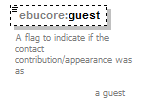 |
||||||
| namespace | urn:ebu:metadata-schema:ebuCore_2014 | ||||||
| type | xs:boolean | ||||||
| properties |
|
||||||
| annotation |
|
||||||
| source | <xs:element name="guest" type="boolean" minOccurs="0"> <xs:annotation> <xs:documentation>A flag to indicate if the contact contribution/appearance was as a guest</xs:documentation> </xs:annotation> </xs:element> |
element contactDetailsType/gender
| diagram |  |
||||||||||||||||||||||||||||||||||||
| namespace | urn:ebu:metadata-schema:ebuCore_2014 | ||||||||||||||||||||||||||||||||||||
| type | ebucore:elementType | ||||||||||||||||||||||||||||||||||||
| properties |
|
||||||||||||||||||||||||||||||||||||
| attributes |
|
||||||||||||||||||||||||||||||||||||
| annotation |
|
||||||||||||||||||||||||||||||||||||
| source | <xs:element name="gender" type="ebucore:elementType" minOccurs="0"> <xs:annotation> <xs:documentation> An element to facilitate filtering / search on gender, e.g. male or female. </xs:documentation> </xs:annotation> </xs:element> |
element contactDetailsType/relatedInformationLink
| diagram | 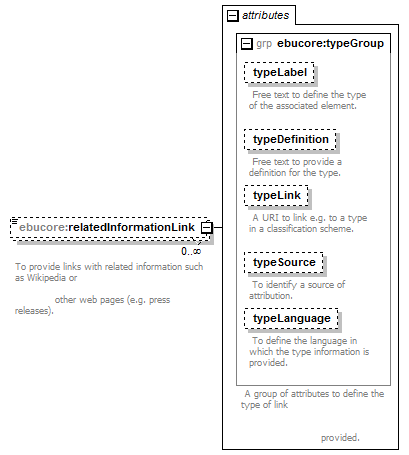 |
||||||||||||||||||||||||||||||||||||||||||||||
| namespace | urn:ebu:metadata-schema:ebuCore_2014 | ||||||||||||||||||||||||||||||||||||||||||||||
| type | extension of xs:anyURI | ||||||||||||||||||||||||||||||||||||||||||||||
| properties |
|
||||||||||||||||||||||||||||||||||||||||||||||
| attributes |
|
||||||||||||||||||||||||||||||||||||||||||||||
| annotation |
|
||||||||||||||||||||||||||||||||||||||||||||||
| source | <xs:element name="relatedInformationLink" minOccurs="0" maxOccurs="unbounded"> <xs:annotation> <xs:documentation>To provide links with related information such as Wikipedia or other web pages (e.g. press releases).</xs:documentation> </xs:annotation> <xs:complexType> <xs:simpleContent> <xs:extension base="anyURI"> <xs:attributeGroup ref="ebucore:typeGroup"> <xs:annotation> <xs:documentation> A group of attributes to define the type of link provided. </xs:documentation> </xs:annotation> </xs:attributeGroup> </xs:extension> </xs:simpleContent> </xs:complexType> </xs:element> |
element contactDetailsType/relatedContacts
| diagram | 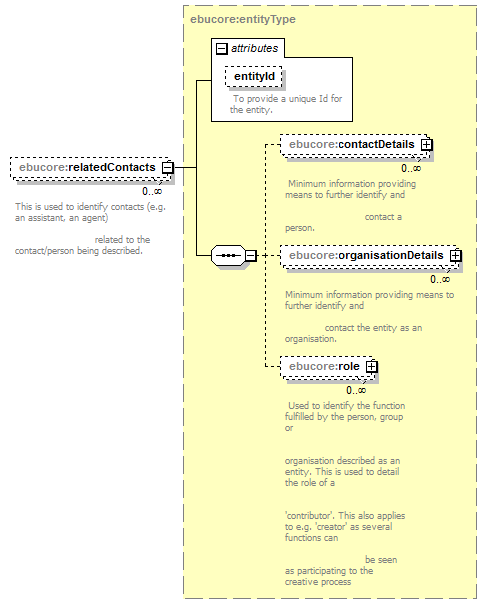 |
||||||||||||||
| namespace | urn:ebu:metadata-schema:ebuCore_2014 | ||||||||||||||
| type | ebucore:entityType | ||||||||||||||
| properties |
|
||||||||||||||
| children | ebucore:contactDetails ebucore:organisationDetails ebucore:role | ||||||||||||||
| attributes |
|
||||||||||||||
| annotation |
|
||||||||||||||
| source | <xs:element name="relatedContacts" type="ebucore:entityType" minOccurs="0" maxOccurs="unbounded"> <xs:annotation> <xs:documentation>This is used to identify contacts (e.g. an assistant, an agent) related to the contact/person being described. </xs:documentation> </xs:annotation> </xs:element> |
element contactDetailsType/skill
| diagram | 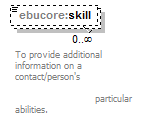 |
||||||
| namespace | urn:ebu:metadata-schema:ebuCore_2014 | ||||||
| type | xs:string | ||||||
| properties |
|
||||||
| annotation |
|
||||||
| source | <xs:element name="skill" type="string" minOccurs="0" maxOccurs="unbounded"> <xs:annotation> <xs:documentation>To provide additional information on a contact/person's particular abilities. </xs:documentation> </xs:annotation> </xs:element> |
XML Schema documentation generated by XMLSpy Schema Editor http://www.altova.com/xmlspy